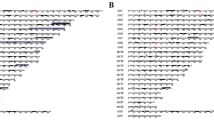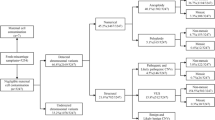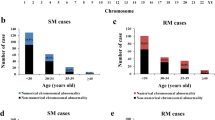Abstract
Using chromosome microarray analysis, 52 samples of placental tissues from first trimester human spontaneous abortions were examined. One hundred twenty copy number variations (CNVs) were identified, affecting one or more genes (total of 427 genes). Using enrichment analysis with the mammalian phenotype ontology, all genes were divided into 183 categories (p ≤ 0.05). The embryogenesis category included 22 genes: AIP, BMP4, BMP5, CDKN1C, EXT1, GAB1, H19, HOXD13, IGF2, KIT, LDHA, NKX2-5, NRK, PEG3, PHLDA2, SMCHD1, SMN1, TBX3, TGIF1, TH, TLX2, and TRR. In this paper, the functions of each of the above genes and pathological phenotypes associated with mutations in them are discussed. A hypothesis of the pleiotropic effect of genes involved in CNVs in spontaneous abortions is proposed.
Similar content being viewed by others
REFERENCES
Kearney, H.M., Thorland, E.C., Brown, K.K., et al., American College of Medical Genetics standards and guidelines for interpretation and reporting of postnatal constitutional copy number variants, Genet. Med., 2011, vol. 13, no. 7, pp. 680–685. https://doi.org/10.1097/GIM.0b013e3182217a3a
Capalbo, A., Rienzi, L., and Ubaldi, F.M., Diagnosis and clinical management of duplications and deletions, Fertil. Steril., 2017, vol. 107, no. 1, pp. 12–18. https://doi.org/10.1016/j.fertnstert.2016.11.002
Schaeffer, A.J., Chung, J., Heretis, K., et al., Comparative genomic hybridization–array analysis enhances the detection of aneuploidies and submicroscopic imbalances in spontaneous miscarriages, Am. J. Hum. Genet., 2004, vol. 74, no. 6, pp. 1168–1174. https://doi.org/10.1086/421250
Benkhalifa, M., Kasakyan, S., Clement, P., et al., Array comparative genomic hybridization profiling of first-trimester spontaneous abortions that fail to grow in vitro, Prenat. Diagn., 2005, vol. 25, no. 10, pp. 894–900. https://doi.org/10.1002/pd.1230
Ballif, B.C., Kashork, C.D., Saleki, R., et al., Detecting sex chromosome anomalies and common triploidies in products of conception by array-based comparative genomic hybridization, Prenat. Diagn., 2006, vol. 26, no. 4, pp. 333–339. https://doi.org/10.1002/pd.1411
Shimokawa, O., Harada, N., Miyake, N., et al., Array comparative genomic hybridization analysis in first-trimester spontaneous abortions with ‘normal’ karyotypes, Am. J. Hum. Genet., vol. 140, no. 18, pp. 1931–1935. https://doi.org/10.1002/ajmg.a.31421
Zhang, Y.X., Zhang, Y.P., Gu, Y., et al., Genetic analysis of first-trimester miscarriages with a combination of cytogenetic karyotyping, microsatellite genotyping and arrayCGH, Clin. Genet., 2009, vol. 75, no. 2, pp. 133–140. https://doi.org/10.1111/j.1399-0004.2008.01131.x
Robberecht, C., Schuddinck, V., Fryns, J.P., and Vermeesch, J.R., Diagnosis of miscarriages by molecular karyotyping: benefits and pitfalls, Genet. Med., 2009, vol. 11, no. 9, pp. 646–654. https://doi.org/10.1097/GIM.0b013e3181abc92a
Menten, B., Swerts, K., Delle, ChiaieB., et al., Array comparative genomic hybridization and flow cytometry analysis of spontaneous abortions and mors in utero samples, BMC Med. Genet., 2009, vol. 10, pp. 89–93. https://doi.org/10.1186/1471-2350-10-89
Warren, J.E., Turok, D.K., Maxwell, T.M., et al., Array comparative genomic hybridization for genetic evaluation of fetal loss between 10 and 20 weeks of gestation, Obstet. Gynecol., 2009, vol. 114, no. 5, pp. 1093–1102. https://doi.org/10.1097/AOG.0b013e3181bc6ab0
Rajcan-Separovic, E., Diego-Alvarez, D., Robinson, W.P., et al., Identification of copy number variants in miscarriages from couples with idiopathic recurrent pregnancy loss, Hum. Reprod., 2010, vol. 25, no. 11, pp. 2913–2922. https://doi.org/10.1093/humrep/deq202
Rajcan-Separovic, E., Qiao, Y., Tyson, C., et al., Genomic changes detected by array CGH in human embryos with developmental defects, Mol. Hum. Reprod., 2010, vol. 16, no. 2, pp. 125–134. https://doi.org/10.1093/molehr/gap083
Lathi, R.B., Massie, J.A., Loring, M., et al., Informatics enhanced SNP microarray analysis of 30 miscarriage samples compared to routine cytogenetics, PLoS One, 2012, vol. 7, no. 3. e31282. https://doi.org/10.1371/journal.pone.0031282
Gao, J., Liu, C., Yao, F., et al., Array-based comparative genomic hybridization is more informative than conventional karyotyping and fluorescence in situ hybridization in the analysis of first-trimester spontaneous abortion, Mol. Cytogenet., 2012, vol. 5, no. 1, pp. 33. https://doi.org/10.1186/1755-8166-5-33
Robberecht, C., Pexsters, A., Deprest, J., et al., Cytogenetic and morphological analysis of early products of conception following hystero-embryoscopy from couples with recurrent pregnancy loss, Prenat. Diagn., 2012, vol. 32, no. 10, pp. 933–942. https://doi.org/10.1002/pd.3936
Lebedev, I.N., Kashevarova, A.A., Skryabin, N.A., et al., Array-based comparative genomic hybridization (array-CGH) in analysis of chromosomal aberrations and CNV polymorphism in bligted ovum pregnancies, Zh. Akush. Zhen. Bolezn., 2013, vol. 62, no. 2, pp. 117–125.
Viaggi, C.D., Cavani, S., Malacarne, M., et al., First-trimester euploid miscarriages analysed by array-CGH, J. Appl. Genet., 2013, vol. 54, no. 3, pp. 353–359. https://doi.org/10.1007/s13353-013-0157-x
Bug, S., Solfrank, B., Schmitz, F., et al., Diagnostic utility of novel combined arrays for genome-wide simultaneous detection of aneuploidy and uniparental isodisomy in losses of pregnancy, Mol. Cytogenet., 2014, vol. 7: 43. https://doi.org/10.1186/1755-8166-7-43
Levy, B., Sigurjonsson, S., Pettersen, B., et al., Genomic imbalance in products of conception: single-nucleotide polymorphism chromosomal microarray analysis, Obstet. Gynecol., 2014, vol. 124, pp. 202–209. https://doi.org/10.1097/AOG.0000000000000325
Bagheri, H., Mercier, E., Qiao, Y., et al., Genomic characteristics of miscarriage copy number variants, Mol. Hum. Reprod., 2015, vol. 21, no. 8, pp. 655–661. https://doi.org/10.1093/molehr/gav030
Kasak, L., Rull, K., Sõber, S., and Laan, M., Copy number variation profile in the placental and parental genomes of recurrent pregnancy loss families, Sci. Rep., 2017, vol. 7: 45327. https://doi.org/10.1038/srep45327
Nagirnaja, L., Palta, P., Kasak, L., et al., Structural genomic variation as risk factor for idiopathic recurrent miscarriage, Hum. Mutat., 2014, vol. 35, no. 8, pp. 972–982. https://doi.org/10.1002/humu.22589
Sivakumaran, S., Agakov, F., Theodoratou, E., et al., Abundant pleiotropy in human complex diseases and traits, Am. J. Hum. Genet., 2011, vol. 89, no. 5, pp. 607–618. https://doi.org/10.1016/j.ajhg.2011.10.004
Solovieff, N., Cotsapas, C., Lee, P.H., et al., Pleiotropy in complex traits: challenges and strategies, Nat. Rev. Genet., 2013, vol. 14, no. 7, pp. 483–495. https://doi.org/10.1038/nrg3461
Chiarella, S.E., Rabin, E.E., Ostilla, L.A., et al., aT-catenin: a developmentally dispensable, disease-linked member of the a-catenin family, Tissue Barriers, 2018, vol. 6, no. 2. e1463896. https://doi.org/10.1080/21688370.2018.1463896
Database of Genomic Variants. http://dgv.tcag.ca/ dgv/app/home.
The National Center for Biotechnology. Gene. https://www.ncbi.nlm.nih.gov/gene.
Online Mendelian Inheritance in Man. https://www.omim.org/.
An integrative web-based and mobile gene-list enrichment analysis tool. http://amp.pharm.mssm.edu/Enrichr/#.
Heinritz, W., Hüffmeier, U., Strenge, S., et al., New mutations of EXT1 and EXT2 genes in German patients with multiple osteochondromas, Ann. Hum. Genet., 2009, vol. 73, pp. 283–291. https://doi.org/10.1111/j.1469-1809.2009.00508.x
Ryu, H.H., Kim, T., Kim, J.W., et al., Excitatory neuron-specific SHP2-ERK signaling network regulates synaptic plasticity and memory, Sci. Signal., 2019, vol. 12, no. 571. pii: eaau5755. https://doi.org/10.1126/scisignal.aau5755
He, D., Zeng, H., Chen, J., et al., H19 regulates trophoblastic spheroid adhesion by competitively binding to let-7, Reproduction, 2019, vol. 157, no. 5, pp. 423–430. https://doi.org/10.1530/REP-18-0339
Proia, P., Di Liegro, C.M., Schiera, G., et al., Lactate as a metabolite and a regulator in the central nervous system, Int. J. Mol. Sci., 2016, vol. 17, no. 9: 1450. https://doi.org/10.3390/ijms17091450
Hammond, E.R., Stewart, B., Peek, J.C., et al., Assessing embryo quality by combining non-invasive markers: early time-lapse parameters reflect gene expression in associated cumulus cells, Hum. Reprod., 2015, vol. 30, no. 8, pp. 1850–1860. https://doi.org/10.1093/humrep/dev121
Terada, R., Warren, S., Lu, J.T., et al., Ablation of Nkx2-5 at mid-embryonic stage results in premature lethality and cardiac malformation, Cardiovasc. Res., 2011, vol. 91, no. 2, pp. 289–299. https://doi.org/10.1093/cvr/cvr037
Morioka, Y., Nam, J.M., and Ohashi, T., Nik-related kinase regulates trophoblast proliferation and placental development by modulating AKT phosphorylation, PLoS One, 2017, vol. 12, no. 2. e0171503. https://doi.org/10.1371/journal.pone.0171503
Frey, W.D. and Kim, J., Tissue-specific contributions of paternally expressed gene 3 in lactation and maternal care of Mus musculus, PLoS One, 2015, vol. 10, no. 12. e0144459. https://doi.org/10.1371/journal.pone.0144459
Ye, A., Kim, H., and Kim, J., PEG3 control on the mammalian MSL complex, PLoS One, 2017, vol. 12, no. 6. e0178363. https://doi.org/10.1371/journal.pone.0178363
Broad, K.D., Curley, J.P., and Keverne, E.B., Increased apoptosis during neonatal brain development underlies the adult behavioral deficits seen in mice lacking a functional paternally expressed gene 3 (Peg3), Dev. Neurobiol., 2009, vol. 69, no. 5, pp. 314–325. https://doi.org/10.1002/dneu.20702
Sõber, S., Rull, K., Reiman, M., et al., RNA sequencing of chorionic villi from recurrent pregnancy loss patients reveals impaired function of basic nuclear and cellular machinery, Sci. Rep., 2016, vol. 6: 38439. https://doi.org/10.1038/srep38439
Green, B.B., Kappil, M., Lambertini, L., et al., Expression of imprinted genes in placenta is associated with infant neurobehavioral development, Epigenetics, 2015, vol. 10, no. 9, pp. 834–841. https://doi.org/10.1080/15592294.2015.1073880
Pathirage, N.A., Cocquebert, M., Sadovsky, Y., et al., Homeobox gene transforming growth factor β-induced factor-1 (TGIF-1) is a regulator of villous trophoblast differentiation and its expression is increased in human idiopathic fetal growth restriction, Mol. Hum. Reprod., 2013, vol. 19, no. 10, pp. 665–675. https://doi.org/10.1093/molehr/gat042
Tang, S.J., Hoodless, P.A., Lu, Z., et al., The Tlx-2 homeobox gene is a downstream target of BMP signalling and is required for mouse mesoderm development, Development, 1998, vol. 125, no. 10, pp. 1877–1887.
Lin, B.C., Sullivan, R., Lee, Y., et al., Deletion of the aryl hydrocarbon receptor-associated protein 9 leads to cardiac malformation and embryonic lethality, J. Biol. Chem., 2007, vol. 282, no. 49, pp. 35924–35932. https://doi.org/10.1074/jbc.M705471200
Chen, B., Liu, P., Hujber, E.J., et al., AIP limits neurotransmitter release by inhibiting calcium bursts from the ryanodine receptor, Nat. Commun., 2017, vol. 8, no. 1: 1380. https://doi.org/10.1038/s41467-017-01704-z
Georgitsi, M., Heliovaara, E., Paschke, R., et al., Large genomic deletions in AIP in pituitary adenoma predisposition, J. Clin. Endocrinol. Metab., 2008, vol. 93, no. 10, pp. 4146–4151. https://doi.org/10.1210/jc.2008-1003
Winnier, G., Blessing, M., Labosky, P.A., and Hogan, B.L., Bone morphogenetic protein-4 is required for mesoderm formation and patterning in the mouse, Genes Dev., 1995, vol. 9, no. 17, pp. 2105–2116.
Capkova, P., Santava, A., Markova, I., et al., Haploinsufficiency of BMP4 and OTX2 in the foetus with an abnormal facial profile detected in the first trimester of pregnancy, Mol. Cytogenet., 2017, vol. 10: 47. https://doi.org/10.1186/s13039-017-0351-3
Nolen, L.D., Amor, D., Haywood, A., et al., Deletion at 14q22-23 indicates a contiguous gene syndrome comprising anophthalmia, pituitary hypoplasia, and ear anomalies, Am. J. Med. Genet., Part A, 2006, vol. 140, no. 16, pp. 1711–1718. https://doi.org/10.1002/ajmg.a.31335
Takahashi, K., Nakayama, K., and Nakayama, K., Mice lacking a CDK inhibitor, p57Kip2, exhibit skeletal abnormalities and growth retardation, J. Biochem., 2000, vol. 127, no. 1, pp. 73–83.
Zhang, P., Liégeois, N.J., Wong, C., et al., Altered cell differentiation and proliferation in mice lacking p57KIP2 indicates a role in Beckwith–Wiedemann syndrome, Nature, 1997, vol. 387, no. 6629, pp. 151–158. https://doi.org/10.1038/387151a0
De Crescenzo, A., Sparago, A., Cerrato, F., et al., Paternal deletion of the 11p15.5 centromeric-imprinting control region is associated with alteration of imprinted gene expression and recurrent severe intrauterine growth restriction, J. Med. Genet., 2013, vol. 50, no. 2, pp. 99–103. https://doi.org/10.1136/jmedgenet-2012-101352
Zhuang, L., Gerber, S.D., Kuchen, S., et al., Deletion of exon 8 from the EXT1 gene causes multiple osteochondromas (MO) in a family with three affected members, Springerplus, 2016, vol. 5: 71. https://doi.org/10.1186/s40064-016-1695-6
Lin, X., Wei, G., Shi, Z., et al., Disruption of gastrulation and heparan sulfate biosynthesis in EXT1-deficient mice, Dev. Biol., 2000, vol. 224, no. 2, pp. 299–311. https://doi.org/10.1006/dbio.2000.9798
Itoh, M., Yoshida, Y., Nishida, K., et al., Role of Gab1 in heart, placenta, and skin development and growth factor- and cytokine-induced extracellular signal-regulated kinase mitogen-activated protein kinase activation, Mol. Cell Biol., 2000, vol. 20, no. 10, pp. 3695–3704.
Fryssira, H., Amenta, S., Kanber, D., et al., A novel large deletion of the ICR1 region including H19 and putative enhancer elements, BMC Med. Genet., 2015, vol. 16: 30. https://doi.org/10.1186/s12881-015-0173-2
Grønskov, K., Poole, R.L., Hahnemann, J.M., et al., Deletions and rearrangements of the H19/IGF2 enhancer region in patients with Silver—Russell syndrome and growth retardation, J. Med. Genet., 2011, vol. 48, no. 5, pp. 308–311. https://doi.org/10.1136/jmg.2010.086504
Radhakrishnan P, Nayak SS, Pai MV et al. Occurrence of synpolydactyly and omphalocele in a fetus with a HOXD13 mutation, J. Pediatr. Genet., 2017, vol. 6, no. 3, pp. 194–197. https://doi.org/10.1055/s-0037-1602142
Goodman, F., Giovannucci-Uzielli, M.L., Hall, C., et al., Deletions in HOXD13 segregate with an identical, novel foot malformation in two unrelated families, Am. J. Hum. Genet., 1998, vol. 63, no. 4, pp. 992–1000. https://doi.org/10.1086/302070
Haruta, M., Arai, Y., Sugawara, W., et al., Duplication of paternal IGF2 or loss of maternal IGF2 imprinting occurs in half of Wilms tumors with various structural WT1 abnormalities, Genes Chromosomes Cancer, 2008, vol. 47, no. 8, pp. 712–727. https://doi.org/10.1002/gcc.20572
Quek, R., Farid, M., Kanjanapan, Y., et al., Prognostic significance of KIT exon 11 deletion mutation in intermediate-risk gastrointestinal stromal tumor, Asia Pac. J. Clin. Oncol., 2017, vol. 13, no. 3, pp. 115–124. https://doi.org/10.1111/ajco.12603
Wit, J.M., van Duyvenvoorde, H.A., van Klinken, J.B., et al., Copy number variants in short children born small for gestational age, Horm. Res. Paediatr., 2014, vol. 82, no. 5, pp. 310–318. https://doi.org/10.1159/000367712
Midic, U., Vincent, K.A., Wang, K., et al., Novel key roles for structural maintenance of chromosome flexible domain containing 1 (Smchd1) during preimplantation mouse development, Mol. Reprod. Dev., 2018, vol. 85, no. 7, pp. 635–648. https://doi.org/10.1002/mrd.23001
Kashevarova, A.A., Nazarenko, L.P., Skryabin, N.A., et al., A mosaic intragenic microduplication of LAMA1 and a constitutional 18p11.32 microduplication in a patient with keratosis pilaris and intellectual disability, Am. J. Med. Genet., Part A, 2018, vol. 176, no. 11, pp. 2395–2403. https://doi.org/10.1002/ajmg.a.40478
Monani, U.R., Sendtner, M., Coovert, D.D., et al., The human centromeric survival motor neuron gene (SMN2) rescues embryonic lethality in Smn –/– mice and results in a mouse with spinal muscular atrophy, Hum. Mol. Genet., 2000, vol. 9, no. 3, pp. 333–339.
Cogulu, O., Durmaz, B., Pehlivan, S., et al., Evaluation of the SMN and NAIP genes in a family: homozygous deletion of the SMN2 gene in the fetus and outcome of the pregnancy, Genet. Test Mol. Biomarkers, 2009, vol. 13, no. 3, pp. 287–288. https://doi.org/10.1089/gtmb.2008.0139
Frank, D.U., Carter, K.L., Thomas, K.R., et al., Lethal arrhythmias in Tbx3-deficient mice reveal extreme dosage sensitivity of cardiac conduction system function and homeostasis, Proc. Natl. Acad. Sci. U.S.A., 2012, vol. 109, no. 3. E154–E163. https://doi.org/10.1073/pnas.1115165109
Forzano, F., Foley, P.A., Keane, M.R., et al., Contiguous gene deletion of TBX5 and TBX3: report of another case, Clin. Dysmorphol., 2018, vol. 27, no. 1, pp. 6–8. https://doi.org/10.1097/MCD.0000000000000199
Rosenfeld, J.A., Ballif, B.C., Martin, D.M., et al., Clinical characterization of individuals with deletions of genes in holoprosencephaly pathways by aCGH refines the phenotypic spectrum of HPE, Hum. Genet., 2010, vol. 127, no. 4, pp. 421–440. https://doi.org/10.1007/s00439-009-0778-7
Buza, N., McGregor, S.M., Barroilhet, L., et al., Paternal uniparental isodisomy of tyrosine hydroxylase locus at chromosome 11p15.4: spectrum of phenotypical presentations simulating hydatidiform moles, Mod. Pathol., 2019. https://doi.org/10.1038/s41379-019-0266-0
Herceg, Z., Hulla, W., Gell, D., et al., Disruption of Trrap causes early embryonic lethality and defects in cell cycle progression, Nat. Genet., 2001, vol. 29, no. 2, pp. 206–211. https://doi.org/10.1038/ng725
Cogné, B., Ehresmann, S., Beauregard-Lacroix, E., et al., Missense variants in the histone acetyltransferase complex component gene TRRAP cause autism and syndromic intellectual disability, Am. J. Hum. Genet., 2019, vol. 104, no. 3, pp. 530–541. https://doi.org/10.1016/j.ajhg.2019.01.010
Cancemi, D., Urciuoli, M., Morelli, F., et al., A case of polimalformed fetus with a microdeletion of CTNNA3 gene, J. Prenat. Med., 2016, vol. 10, nos. 3–4, pp. 20–22. https://doi.org/10.11138/jpm/2016.10.3.020
Bacchelli, E., Ceroni, F., Pinto, D., et al., A CTNNA3 compound heterozygous deletion implicates a role for αT-catenin in susceptibility to autism spectrum disorder, J. Neurodev. Disord., 2014, vol. 6, no. 1: 17. https://doi.org/10.1186/1866-1955-6-17
ACKNOWLEDGMENTS
The study was carried at the Medical Genomics Center for Collective Use, using the biological collection of the Biobank of Northern Eurasia of the Research Institute of Medical Genetics, Tomsk National Research Medical Center.
Funding
This work was supported by the Russian Foundation for Basic Research (grant no. 14-04-32047) and the state task for the Research Institute of Medical Genetics, Tomsk National Research Medical Center, Russian Academy of Sciences (state registration number AAAA-A19-119020890005-5).
Author information
Authors and Affiliations
Corresponding author
Ethics declarations
Conflicts of interest. The authors declare that they have no conflict of interest.
Statement of compliance with standards of research involving humans as subjects. All procedures carried out in the study with the participation of people comply with the ethical standards of the institutional and/or national research ethics committee and the 1964 Helsinki Declaration and its subsequent changes or comparable standards of ethics. Informed voluntary consent was obtained from each of the participants in the study.
Additional information
Translated by A. Kashevarova
Supplementary material
Rights and permissions
About this article
Cite this article
Kashevarova, A.A., Skryabin, N.A., Nikitina, T.V. et al. Ontogenetic Pleiotropy of Genes Involved in CNVs in Human Spontaneous Abortions. Russ J Genet 55, 1214–1226 (2019). https://doi.org/10.1134/S1022795419100065
Received:
Revised:
Accepted:
Published:
Issue Date:
DOI: https://doi.org/10.1134/S1022795419100065




